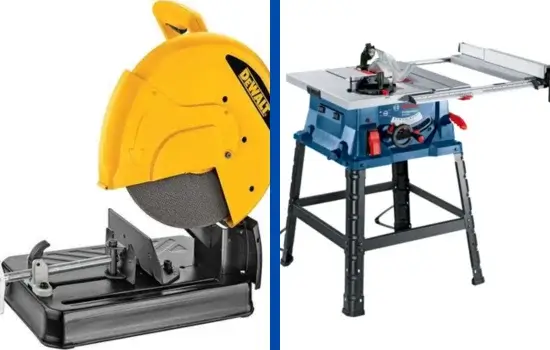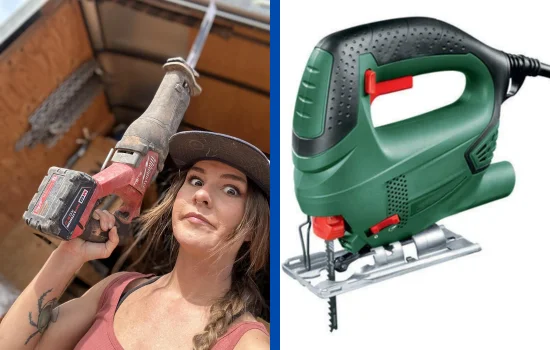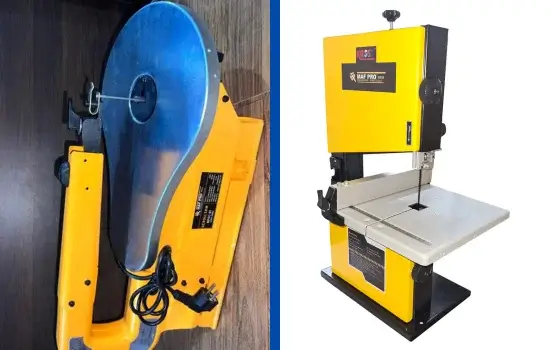For woodworking, metalworking, or construction projects, selecting the right saw can make a huge difference in your efficiency, safety, and the quality of your work. While chop saws and table saws may appear similar at first glance, they are built with very different purposes in mind. A chop saw is generally used for cutting tough materials like metal and masonry, while a table saw excels in making long, straight cuts in wood and other materials.
This article will provide an in-depth comparison between chop saws and table saws, examining their specific uses, cutting capabilities, design, portability, safety features, and more to help you choose the best tool for your needs.
Quick Definitions about Chop Saw and Table Saw
Chop Saw
A chop saw is a powerful, fixed-position saw designed to make quick, straight cuts. It’s ideal for cutting through metal, masonry, and sometimes dense wood. Using an abrasive disc rather than a toothed blade, chop saws are known for their heavy-duty capabilities and are commonly found in metalworking and construction environments.
Table Saw
A table saw is a bench-mounted tool with a flat, stable surface and a rotating blade that protrudes through the table’s center. It is particularly suited for making long, straight cuts (rip cuts) and is widely used in woodworking. Table saws can handle sheet goods and large panels efficiently, making them a staple in most woodworking shops.
Key Differences Between Chop Saw and Table Saw
| Feature | Chop Saw | Table Saw |
|---|---|---|
| Primary Function | Straight cuts on tough materials | Rip cuts and crosscuts in wood |
| Cutting Motion | Downward chop motion | Material fed into the fixed blade |
| Blade Type | Abrasive disc (for metal) | Toothed blade (for wood and some plastics) |
| Angle Adjustability | Fixed, typically 90-degree cuts | Adjustable blade height and angle |
| Material Suitability | Metals, masonry, thick wood | Wood, sheet goods, softer materials |
| Portability | Heavier, usually stationary | Heavier but often mounted on mobile bases |
| Precision | Lower precision, rugged cuts | High precision, particularly in rip cuts |
| Applications | Metalworking, masonry, heavy-duty cuts | Woodworking, cabinetry, panel work |
| Safety Features | Blade guard, sometimes spark deflectors | Blade guard, riving knife, anti-kickback pawls |
| Cost | Mid-range to high | Mid-range to high, depending on features |
Detailed Comparison of Chop Saw and Table Saw
1. Primary Function and Applications
- Chop Saw: Chop saws are designed primarily for straight, quick cuts at 90 degrees. They’re equipped to handle tough materials such as metal, masonry, and thick plastic. Due to their powerful motors and durable abrasive discs, chop saws are perfect for heavy-duty cutting jobs found in metalworking shops and construction sites. However, they’re limited in their applications, as they cannot perform angled or intricate cuts effectively.
- Table Saw: Table saws are incredibly versatile for woodworking projects, handling both rip cuts (cutting along the grain of the wood) and crosscuts (cutting across the grain). They’re ideal for long, straight cuts, making them essential for cabinetry, furniture-making, and working with sheet goods. Table saws also come with adjustable fences and miter gauges, allowing for precision and versatility in both straight and angled cuts.
2. Cutting Capacity and Types of Cuts
- Chop Saw: Chop saws are primarily suited for straight, 90-degree cuts. They use a downward chopping motion, and their blade is fixed in place, which restricts them from making rip cuts or angled cuts. The blade type—usually an abrasive disc—enables chop saws to cut through thick, dense materials that would be challenging for other saws to handle. While their lack of versatility in cutting styles can be limiting, chop saws excel in power.
- Table Saw: Table saws are capable of making a variety of cuts, including rip cuts, crosscuts, and even beveled cuts by tilting the blade. The material is pushed through the saw’s rotating blade, allowing for a longer and more continuous cutting action compared to a chop saw. With accessories like miter gauges and fences, table saws can make precise cuts at various angles, making them invaluable in woodworking and cabinetry.
3. Blade Types and Materials
- Chop Saw: Chop saws usually use an abrasive disc rather than a toothed blade. This abrasive disc is specifically engineered for cutting through dense and hard materials, including metal, masonry, and concrete. Because of the abrasive blade, chop saws generate more sparks and heat than a table saw, which is something to consider if you’re working in an indoor environment.
- Table Saw: Table saws typically use toothed blades, with a variety of tooth configurations available depending on the type of cut and material. Blades with fine teeth are used for smooth cuts in wood, while coarse blades can be used for faster cuts. Table saws can accommodate different blade types, allowing the user to switch between ripping, crosscutting, and fine finishing.
4. Angle Adjustability and Precision
- Chop Saw: Chop saws are limited in their adjustability, typically locked into a 90-degree cut position. The design is straightforward and focused on delivering quick, straight cuts rather than precision or versatility in angles. Some models may offer limited angle adjustments, but they’re generally restricted to small increments. The lack of precision adjustments makes chop saws less suitable for detailed woodworking.
- Table Saw: Table saws provide a high level of adjustability and precision. Users can tilt the blade to achieve angled cuts and adjust the blade height to control the depth of the cut. With miter gauges and fence systems, table saws can make highly accurate cuts, including angled cuts for joinery. This makes the table saw a precision tool for woodworking and cabinet-making.
5. Portability and Workspace Requirements
- Chop Saw: Due to their heavy-duty design, chop saws are generally larger and less portable than miter saws, although there are compact models available for on-site use. They are often mounted on stands or tables to provide stability for metal and masonry cutting. The stationary nature of chop saws limits them to workshop or construction site use, where they can remain securely set up.
- Table Saw: Table saws are also heavier tools, often built into a workbench or mounted on mobile bases with wheels for added portability. Larger, cabinet-style table saws are typically stationary and require a dedicated workspace. Portable job-site table saws are available and can be moved around more easily, though they still require a stable surface to operate.
6. Safety Features
- Chop Saw: Chop saws have blade guards that protect the user from the abrasive disc. Many also have spark deflectors due to the heat and sparks generated when cutting metal. Because chop saws use abrasive blades that can create significant heat, users should always wear safety gear, such as gloves and goggles, to avoid potential hazards.
- Table Saw: Table saws include several safety features, including a riving knife or splitter to prevent kickback—a common danger when working with wood. Anti-kickback pawls also help secure the material during cuts, and blade guards protect the user’s hands from the rotating blade. Some high-end models include electronic braking systems that stop the blade quickly to prevent accidents.
7. Cost Considerations
- Chop Saw: Chop saws are generally mid-range to high-priced, depending on their power and durability. Since they’re specialized for heavy-duty cutting, the investment can be worth it for metalworkers or contractors who frequently work with tough materials. Abrasive disc costs are also a consideration, as they need to be replaced more frequently than toothed blades.
- Table Saw: Table saws vary widely in price, with entry-level models for hobbyists and high-end cabinet saws for professional woodworkers. The cost depends largely on the table saw’s size, power, and additional features. For woodworkers, the versatility and precision of a table saw make it a valuable investment, especially if they work with a range of materials and need accurate cuts.
Pros and Cons of Chop Saw and Table Saw
Chop Saw Pros:
- Ideal for cutting metal, masonry, and dense materials
- Simple, straightforward design focused on power
- Fast, efficient 90-degree cuts for tough materials
Chop Saw Cons:
- Limited to straight cuts, with little angle flexibility
- Heavy and less portable than some other saws
- Can generate sparks, requiring additional safety measures
Table Saw Pros:
- Versatile, with capabilities for rip, cross, and bevel cuts
- Highly accurate and suitable for detailed woodworking
- Adjustable fences and miter gauges improve precision
Table Saw Cons:
- Not suitable for cutting heavy metals or masonry
- Takes up considerable space, especially cabinet models
- Can be costly, especially for high-precision models
Choosing Between a Chop Saw and a Table Saw
When deciding between a chop saw and a table saw, consider the primary materials you’ll be working with and the types of cuts you need to make most often.
- If you’re focused on metalworking, construction, or masonry projects that require fast, straight cuts, a chop saw is likely the best choice. Its power and simplicity make it well-suited for tough jobs, although it is limited in flexibility.
- If you’re a woodworker or work with sheet goods and cabinetry, a table saw will be far more valuable. Its versatility, precision, and range of adjustable features make it ideal for creating fine, detailed cuts and handling large pieces of wood with ease.
In summary, both chop saws and table saws are highly effective for specific tasks. By understanding their unique features, limitations, and applications, you can make an informed choice that enhances your productivity and quality of work.


